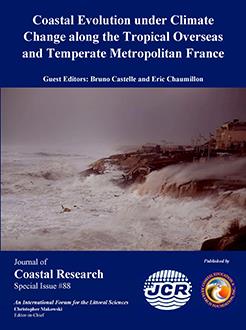Stéphan, P.; Blaise, E.; Suanez, S.; Fichaut, B.; Autret, R.; Floc'h, F.; Cuq, V.; Le Dantec, N.; Ammann, J.; David, L.; Jaud, M., and Delacourt, C., 2019. Long, medium, and short-term shoreline dynamics of the Brittany Coast (western France). In: Castelle, B. and Chaumillon, E. (eds.), Coastal Evolution under Climate Change along the Tropical Overseas and Temperate Metropolitan France. Journal of Coastal Research, Special Issue No. 88, pp. 89–109. Coconut Creek (Florida), ISSN 0749-0208.
This paper aims to analyze the shoreline changes of coastal accumulations (sandy and gravel beaches/barriers) of Brittany (Western France). Three long, medium, and short term spatio-temporal scale observations are taken into consideration for the assessment of shoreline dynamics at this regional scale. Firstly, the long-term shoreline position evolution is based on a comparison of two sets of aerial orthophotos (1949-1952 and 2006-2009). A total of 652 beaches were analyzed in order to map and quantify erosion (35% of the total studied coastline), stability (38%), and accretion (27%) over the last 60 years. In detail, these percentages vary significantly according to the beach/barrier morphologies (spits vs pocket beaches), sediment composition (sandy vs gravelly), and hydrodynamic context (exposed vs sheltered). Secondly, a pluri-annual (i.e., medium-term) shoreline change analysis based on five representative beaches was conducted. This analysis was also based on image processing using sets of aerial photos taken every five years over the last 60 years (1948-2013). Results show an alternation of significant erosion- and accretion-dominated periods (respectively EDP and ADP), with six main EDP (i.e., periods 1962-1968, 1977-1978, 1980-1985, 1987-1990, 1993-1997, and 2013-2014) related to an increase in the frequency of extreme water levels associated with storm events. Finally, the short-term change analysis based on high-frequency monitoring of 11 sites was carried out over the period 1998-2017. These surveys, based on field topo-morphological measurements, highlight the impact of five morphogenetic events associated with significant storm events: 1998-2000 (storms Lothar and Martin in December 1999), 2008 (storm Johanna on March 10, 2008), the winter of 2013-2014 (a cluster of storms in January, February, and March 2014), 2016 (storm Ruzica/Imogen on February 8, 2016) and 2018 (storm Eleanor on January 2, 2018). A relevant recovery phase, which took place between 2008 and 2012 due to the calm and cold winters, was also recognized. The identification of parameters involved in shoreline variations at these three timescales is important for future management options of the Brittany coast.





